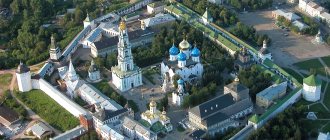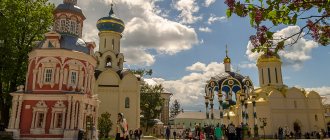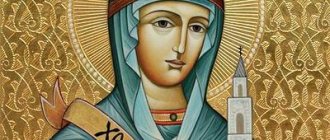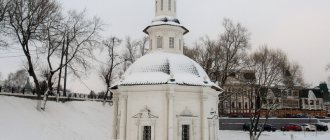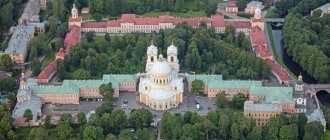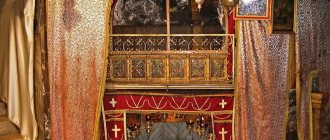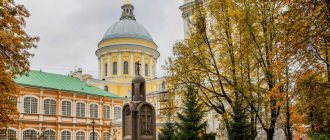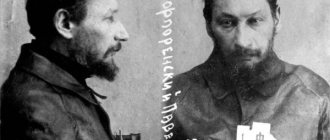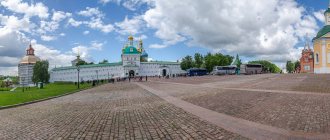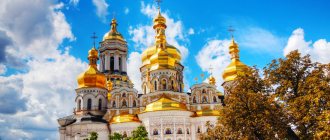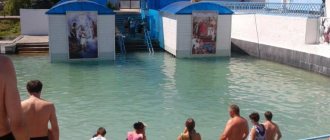The Trinity-Sergius Lavra was founded by one of the most revered saints in Rus' - Sergius of Radonezh. The history of the monastery is connected with many important events of the Russian state: the Battle of Kulikovo, the difficult period of the Mongol-Tatar yoke, the fight against foreign invaders and the first years of the reign of Peter the Great - all these pages of history did not pass by the monastery.
Russian rulers honored the Trinity-Sergius Lavra, came here on pilgrimages and provided assistance to the monastery. Tsar Boris Godunov and members of his family are buried near the walls of the Assumption Cathedral - Tsarina Maria, Tsarevich Theodore and Tsarevna Ksenia, and Olga as a monk.
The Trinity-Sergius Lavra is a working monastery located near Moscow; you can visit it on a day trip or during a tour of the Golden Ring.
Base
Sergei of Radonezh was the son of the pious Rostov boyars Cyril and Maria. As a child, his parents did not bless him for monastic life. Only when, shortly before his death, they went to a monastery, Sergei of Radonezh decided to devote his life to serving God.
But he did not go to one of the existing monasteries, but together with his older brother Stefan settled in a deep forest.
For reference: Sergei of Radonezh (in the world Bartholomew) was born in 1313, he was the middle son in the family. His teenage years were spent in study, work and prayer in the city of Radonezh, where his parents settled.
Bartholomew was a deeply religious, kind, honest and modest person; he became the support of his elderly parents, not leaving them until his last days.
The founding date of the Trinity-Sergius Lavra is considered to be 1337, when 23-year-old Bartholomew, together with his brother, built a hut and a small church dedicated to the Holy Trinity on a small hill in the forest, away from the noise of roads and villages.
This is how the history of the Trinity-Sergius Lavra began.
Brother Stefan could not stand the difficult conditions of a solitary life and went to the Moscow Epiphany Monastery. Sergei of Radonezh lived alone for several years, but soon other monks began to gather around him, each of whom built himself a hut and cultivated his own garden.
Revival of the country
The monastery was founded by St. Sergius of Radonezh in the 14th century. The saint lived very modestly, prayed, worked and raised disciples, but it turned out that for his time he became one of the main people in Russia!
In those years, the Russian land was divided into principalities, which were constantly at war with each other. This is called civil strife. The princes quarreled endlessly, led troops against each other, and sometimes killed people themselves, even their own relatives. This has greatly weakened our people. The Golden Horde, which then ruled Russia, took advantage of the weakness: the Horde khans constantly demanded tribute, raided our cities, villages, villages, robbed, killed and burned everything.
Sometimes Russian princes defeated the invaders, sometimes entire cities rebelled against the Horde. Then the oppression became weaker. But the time has not yet come for a big battle that would completely free our people from the heavy yoke. There was little strength. There were not enough literate people and books. Even simple artisans and craftsmen could not be found during the day. The monastic tradition was also in decline. And some princes were even satisfied with the power of the Horde - with the hands of the khans they dealt with their rivals.
In those days, the monastery of St. Sergius was still very small. A small wooden church, monastic cells, several outbuildings, and all around there are dense forests in which there is not a soul. The rules in the monastery were so strict, and life was so difficult that even the elder brother of Sergius of Radonezh, Stefan, could not stand it and went to live in a Moscow monastery. But gradually other monks gathered around the hermit Sergius, the saint had disciples, and the fame of the saint spread throughout Rus' and beyond.
The monks earned their living by their labor and did not take donations. The Monk Sergius himself, even though he was the son of a noble boyar, worked harder than anyone: every day he walked two kilometers with buckets to bring water to his brothers in the morning, and did carpentry, and chopped wood, and sewed clothes, and prepared food for the brethren.
The monk said that a monk, and especially a priest, cannot be an illiterate ignoramus. His poor monastery, even with the money it had, first of all bought books. And icon painters were always accepted and cared for here.
People from all over the country came to the simple and wise abbot for advice. The monk lived alone in the thicket of the forest, but when princes came to him for advice, he returned to the monastery to reconcile them, explaining that it was impossible to fight with neighbors. And he himself even went to establish peace between the princes in other cities - to Nizhny Novgorod, Ryazan and to a large princely meeting in the city of Pereyaslavl-Zalessky.
Saint Sergius taught people to love and forgive. And he himself set an example of humility: when the monks in the monastery began to argue about which of them was more important, Sergius quietly left the monastery so as not to be the cause of the quarrel. The monks then had difficulty returning him.
But this did not mean that the saint always humbled himself before evil. When necessary, he was firm and strong in faith. The Moscow prince Dmitry Ivanovich once came to Sergius for advice: to submit to the khans of the Horde, knowing that the Russian land would suffer more and more, or to repel a strong, cruel enemy? The monk did not dissuade the prince from fighting. On the contrary, he blessed Dmitry and instructed two of his monks, Peresvet and Oslyaba, to go with the army.
Dmitry defeated the Horde army in 1378 on the Vozha River, and then, in 1380, he gave battle to the Horde beyond the Don, on the Kulikovo Field. The liberation of Russian lands began with the victory in the Battle of Kulikovo. And the prince himself received the nickname Donskoy.
St. Sergius of Radonezh was also glorified by his disciples. After the death of the saint, they dispersed throughout the Russian lands and created new monasteries. The famous northern monasteries - Solovetsky, Kirillo-Belozersky, and others - were founded by the disciples of St. Sergius. People from the Trinity-Sergius Monastery developed the northern lands, and cities arose around the northern monasteries. 70 disciples of Sergius of Radonezh were canonized.
Formation of the monastery
When the number of monks increased to 12, all buildings were surrounded by a fence for safety from animals. There were no leaders in the monastery and, thanks to respect, Sergius of Radonezh played the role of leader. Soon, by order of the Moscow church authorities, he was ordained a priest and appointed abbot.
A charter began to operate in the monastery, in accordance with which the monks formed a single community and began to run a joint household.
In this regard, the structure of the monastery also changed: a refectory and utility rooms were built. The church was located in the center of the monastery, and on four sides of it there were cells. A gate church was built above the main gate in the name of the Holy Great Martyr Demetrius of Thessalonica.
At that time the monastery was poor, there was not enough bread and salt, butter and flour.
In the first decade of its existence, the monastery became widely known, and Sergius of Radonezh was highly respected by Prince Dmitry Donskoy. Metropolitan Alexy of the Russian Orthodox Church wanted the Trinity Abbot to become his successor, but Sergius of Radonezh refused such an honor.
Monastery during the Mongol-Tatar yoke
The time when St. Sergius of Radonezh lived (1314–1392) was very difficult for Rus': constant raids by the Mongol-Tatars forced people to think only about how to survive.
St. Sergius considered it his duty to take care of their spiritual education. On the eve of the Battle of Kulikovo, he blessed Dmitry Donskoy to fight the horde of Mamai. Inspired by the instructions of the abbot, the soldiers of Dmitry Donskoy defeated the army of Mamai.
Also, the Trinity abbot tried to try on the princes who were at war with each other.
The monastery became a real center of culture and education.
However, at that time the monastery was not well fortified; there was only a wooden fence to protect it. Therefore, during the attack on the Russian lands of Khan Toktamysh, the monks were forced to take refuge in a safe place - on the territory of the Tver Principality. This time the monastery survived, but in 1408, during the speech of Khan Edigei, it was destroyed. Thanks to the efforts of Hegumen Nikon, the successor of Sergius of Radonezh, the monastery was rebuilt.
Restoration of the Lavra
Immediately after the end of active hostilities in 1917-1918. In the area adjacent to the monastery, the Bolsheviks created a commission to protect the ancient valuables that were kept in the monastery, as well as organizations to carry out restoration work. But this work was carried out very poorly, since there was no single idea of what the new monastery should look like and why it was needed at all.
On a note! Systematic restoration work began only in 1938 after the young architect Ignatius Trofimov was invited to participate in it.
It took Trofimov two years to prepare a certificate about the museum and a project for restoration work. On February 1, 1940, the Lavra and the surrounding territory were declared the Zagorsk State Historical and Art Museum-Reserve. Trofimov was appointed chief architect, allocating 6 million rubles for restoration.
The war prevented its completion. But despite the hostilities and post-war devastation, the destruction of the monastery was avoided. Some of the monuments were restored, while others were built almost from scratch.
Restoring the Lavra is the primary and most important task that the government set before Trofimov. In 1950 Trofimov’s work was continued by his student, architect V.I. Baldin. In 1963, A.G. got involved in the case. Ustinov, who insisted on a comprehensive restoration of the Lavra ensemble. By the beginning of the 1970s. Most of the restoration work was completed, but the restoration of the monastery did not stop there.
The work of the first architects was continued by the younger generation. Many parts of the monastery can now be seen thanks to the work of architects Yu.D. Belyaeva and Yu.N. Shakhova.
In 1990-2000 The Lavra was restored to its original pre-revolutionary appearance, some walls were repainted, the previous painting was recreated, and the bell tower was repaired. In 2004, the Tsar Bell returned to the bell tower. It had to be cast again because the previous one was melted.
Important! In 1993, UNESCO included the Trinity-Sergius Monastery on the list of world cultural heritage.
Construction of stone churches in the 15th century
In 1422, the year of the official canonization of St. Sergius, the Trinity-Sergius Lavra was decorated with new stone buildings.
Trinity Cathedral
On the site of the old wooden church, the white-stone Trinity Cathedral was erected by the Monk Nikon “in honor and praise” of the founder of the monastery. Among those who contributed funds for the construction was the son of Dmitry Donskoy, Prince of Zvenigorod and Galitsky Yuri Dmitrievich.
Trinity Cathedral is the oldest white-stone church of the monastery, built in 1422–1425. There is often a queue to see the beautiful silver shrine where the relics of St. Sergius of Radonezh rest.
The interior of the cathedral was decorated with paintings made by painters Andrei Rublev and Daniil Cherny. Unfortunately, the frescoes have not survived to this day, but icons by Andrei Rublev can be seen in the unique five-tiered iconostasis.
It was for this iconostasis that the famous icon of Andrei Rublev “The Holy Trinity” was created, which was in the temple before the October Revolution, and then was transferred to the State Tretyakov Gallery, where it is currently located.
Next to the shrine there is an inconspicuous double-leaf forged iron door; this is the entrance to the chapel of the cathedral, the Serapion Chamber, in which Orthodox shrines are kept, there are more than five hundred of them. There is a 5–7 cm hole preserved on the door; this is a trace from a Polish cannonball that flew into the temple during the siege of the monastery and, fortunately, did not explode. The chamber is named after Serapion, the former archimandrite of the Trinity Monastery, who was buried here.
In 1476, Pskov craftsmen erected a brick church-belfry in the name of the Descent of the Holy Spirit on the Apostles.
The fortress walls, towers and the Dmitrievskaya Gate Church were still wooden.
History of the Holy Trinity Sergius Lavra
The Holy Trinity Sergius Lavra owes its appearance to two brothers - Stephen and Bartholomew, born into a boyar family. From childhood, Bartholomew sought to serve God, however, his parents did not give him their blessing to do so. When mother and father, having grown old, decided to go to a monastery, the brothers were still able to leave worldly life.
Formation of the monastery
In 1337, not far from the city of Radonezh, on a hill in a wooded area, Stefan and Bartholomew built a cell and a small church with their own hands. The elder brother could not live in solitude for long, but Bartholomew humbly prayed and served God. Could a 23-year-old young man imagine that the place he chose for his hermit’s life would become the greatest Orthodox shrine? The abbot of one of the monasteries located nearby tonsured Bartholomew a monk under the name Sergius. Thus began the glorious life of Sergius of Radonezh, who in the future had a huge influence on the spiritual life of not only nearby villages and hamlets, but also throughout Rus'. Leading a hermit's life, Sergius learned humility - he worked on the land, prayed intensely and did not desire fame at all. However, fate decreed differently. His church began to attract more and more people who asked him to teach them how to lead a godly life. Other dwellings began to appear near Sergius’s cell. Gradually the area was populated by people who preached Orthodoxy. We can talk about the appearance of a monastery during this period of time, the exact date of its foundation is unknown (according to some sources it is 1337, according to others - 1342). At first, the abbot was the same monk who tonsured Bartholomew - Mitrofan. After his death, this place was taken by the Monk Sergius.
In 1355, some changes took place on the monastery land: it was divided into 3 zones: residential, economic and protective. A new Trinity Church was erected from wood; nearby there were residential buildings - cells and a refectory. The public area contained outbuildings and cultivated land. The territory of the monastery was surrounded by a fence; at the central gate there was a wooden church named after Dmitry of Thessaloniki. The general arrangement of structures on the territory has not undergone major changes. The popularity of the Trinity Monastery as the spiritual center of the Russian lands grew with unusual force. More and more Moscow princes sought blessings here. It is a known fact that Sergius of Radonezh provided enormous support to Dmitry Donskoy, blessing him before the Battle of Kulikovo. The Monk Sergius sent two monks with the army - Peresvet and Ooslablya, contrary to the strict monastic rules. In 1932, Sergius of Radonezh entered into eternal rest and was buried inside the main church. At that moment, one of his students Nikon was listed as abbot.
New life for the monastery
In 1408, disaster struck: Khan Edigei practically wiped the monastery off the face of the earth. But perhaps this marked the beginning of a new stage in the development of the monastery. In 1415, Abbot Nikon laid the foundation for the first building made of stone - the Trinity Cathedral. The construction was carried out by craftsmen from Kosovo, who have found shelter here for some time now. The painting inside the temple was carried out by famous masters of icon painting Andrei Rublev and Daniil Cherny. An interesting fact is that the famous “Trinity” icon was painted specifically to decorate the iconostasis of this cathedral.
In 1469, construction began on another stone building - the refectory. Its peculiarity was that it had the type of a single-pillar chamber; this technique subsequently began to be widely used in architecture. On the lower floor there were refectories for the brethren, and on the upper floor there were royal chambers. In 1476, another temple appeared near the cathedral. During the reign of Ivan the Terrible, who often visited the monastery, the territory was again modified. In particular, white stone walls were erected along the perimeter. Their length was almost one and a half kilometers. Thanks to the dams built and surrounded by high walls, the monastery turned into a real fortress. In the middle of the 16th century, the monastery received a new status - archimandria. Ivan the Terrible contributed to laying the first stone in the construction of the large Assumption Cathedral. However, five years later construction was stopped due to a fire, as a result of which many buildings were severely damaged. The Assumption Cathedral was nevertheless completed, but Ivan the Terrible was not destined to see the built temple; its illumination took place after the death of the sovereign in 1585. By the second half of the 16th century, there were no equals to the Trinity Monastery in the state: it administered almost 3,000 settlements, which not only fully provided themselves with everything they needed, but also carried out trade abroad.
Difficult times - 17th century
In 1608, the siege of the monastery by Polish-Lithuanian invaders began. But this was not the worst thing: a year later, inside the monastery, people began to die en masse from scurvy. But this, fortunately, did not become the reason for the seizure of land. An unknown force made it possible to defend the monastery. Help arrived in time: in the winter of 1610, an army led by Mikhail Skopin-Shuisky liberated the monastery. A few years later, the Trinity-Sergius Monastery was again attacked, this time the Polish prince Vladislav wanted to conquer it. But his dreams were also not destined to come true.
Prosperity of the monastery in the 17th-18th centuries
After the siege, restoration began at a rapid pace: the walls were significantly strengthened, the towers acquired the appearance that has survived to this day. New buildings appeared: a large bell tower, the Church of Mikhail Malein, royal mansions, and a little later - additional stone cells, a hospital complex and 2 more churches. Life flourished - the monastery's possessions began to exceed those of the royal and patriarchal. Under Peter I, a refectory and a church in honor of Sergius of Radonezh, as well as a gate church, appeared here. A little later, the monastery was fortified due to the unexpected possibility of capture by the Swedes. A ditch was dug and 2 stone bridges were built. The earthen fortifications still exist today. After Peter I, interest in the Trinity-Sergius Monastery faded; there was even an option to move it closer to St. Petersburg. However, in 1738 the Spiritual Council began to manage life here.
A new milestone in the development of the Lavra
With the advent of Elizabeth Petrovna to the throne, the next era of development begins. In 1742, a theological seminary was opened here, and in 1744 the monastery was given the title of Lavra, and the Metropolitan of Moscow became its head.
The Empress really loved visiting the Lavra; she contributed to the fact that almost all the buildings inside the monastery changed their appearance compared to the original. The bell tower appeared in 1770, for which a huge bell was cast, its weight was 4065 pounds. The Lavra continues to be the largest spiritual and cultural center; its role was further strengthened after the transfer of the Theological Academy here in 1814. If we exclude the fact that because of this it was necessary to violate the overall integrity of the architectural complex of the monastery buildings, then the Theological Academy made the Lavra an even more powerful means of shaping the spiritual heritage. The 18th - 19th centuries were a time of unprecedented prosperity for the Lavra. The wealth of the monastery increased every year. This was facilitated by the huge amount of land owned by him, peasant souls, as well as active trading activities. The Trinity Monastery was a real treasury: it was there that the relics of many saints were located, including Sergius of Radonezh, Nikon, Metropolitan Joseph, and others. Moreover, it was the walls of this temple that were decorated with the most famous creation of Andrei Rublev - the icon of the Holy Life-Giving Trinity.
Lavra during the Soviet period
At the beginning of the 20th century, a difficult time began that affected the entire monastic life. On one May day in 1920, parishioners were met here for the last time, after which the Lavra was closed and the Theological Academy was dissolved. During the years of Soviet power, many buildings were reconstructed and began to serve as commercial and residential buildings. Most of the ancient bells were melted down. In 1940, work began on establishing a state historical and art museum-reserve here; the authorities tried to completely change the territory; insufficient attention was paid to the preservation of shrines and objects of great value. After the Great Patriotic War, a school was opened here, and a year later the Assumption Cathedral was returned to the Patriarchate. In the post-war period, large-scale restoration work was carried out to give architectural objects a look as close as possible to the original.
Trinity-Sergius Lavra today
In 1993, the Trinity-Sergius Lavra was included in the list of UNESCO World Heritage Sites in Russia. Now the territory of the monastery includes many architectural monuments, the likes of which are not found anywhere else. The modern Lavra is a unique functioning monastery with approximately two hundred monks. Anyone can come to this amazing place - interesting excursions are held every day for pilgrims and tourists from all over the world.
Construction of defensive structures
In the 14th–17th centuries, Rus' experienced severe pressure in the east from the Golden Horde and in the west from the Principality of Lithuania. Only a single state could resist these forces. A unified defensive system began to be created on the scale of the entire Russian state.
The Trinity Lavra of St. Sergius, located on the outskirts of Moscow, became an important fortress designed to protect the capital.
The history of the new defensive structures of the monastery began in the 1540–1550s. Then a stone wall about 1.5 kilometers long was built in the shape of an irregular quadrangle with 12 towers (11 have survived to date). The natural barrier for the enemy was the ravines, and additional obstacles were the dug ditch and pond.
In the middle of the 17th century, the fortifications were strengthened, improved and acquired a modern look.
The walls of the fortress have three battle tiers, and most of the towers have six tiers. The most interesting of them are the Pyatnitskaya and Krasnaya, Utochya and Beer towers.
- The beer tower had a spare, or secret, exit from the fortress, through which sorties took place during the siege of the fortress at the beginning of the 17th century
- The Corner Duck Tower was named so because, according to legend, Tsar Peter the Great used it to shoot ducks swimming in a pond next to the fortress wall.
- The Pyatnitskaya Tower previously had a tower for monitoring the surrounding area. During the siege of the fortress, the tower was destroyed and rebuilt in 1640
- The Red Tower is where the main gate to the fortress is located. Behind it there was previously a gate church built in 1513 in honor of St. Sergius of Radonezh. Later it was rebuilt into a church, topped with five domes in honor of the Nativity of St. John the Baptist.
Creation of the Assumption Cathedral and other churches
Assumption Cathedral
In 1559–1585, a new five-domed cathedral was erected in the center of the monastery, in the east of Cathedral Square. Ivan the Terrible and his family were present at its laying. The temple was built similar to the Assumption Cathedral of the Moscow Kremlin, but was inferior in size. At the same time, the built cathedral was larger than other monastery churches.
Like the cathedrals of Vladimir and Moscow, it was named Assumption. In 1684, the walls, vault and pillars of the temple were decorated with frescoes on biblical themes. In the northwestern part of the cathedral there is the tomb of the family of Tsar Boris Godunov, over which in 1780 a tent tent was erected, which has not survived to this day.
The temple took a long time to build - about 25 years, there was not enough funds and, basically, it was built with royal donations. Ivan the Terrible gave generous contributions for the memorial of the soul of his murdered son. But the consecration of the Assumption Cathedral took place in 1585, after the death of Ivan IV, under his third son, Tsar Feodor Ivanovich.
- Opposite the Assumption Cathedral, on the western side of Cathedral Square, is the Treasury building of fraternal cells. Adjacent to it: from the north - Hospital wards with the tented church of St. Zosima and Savvaty of Solovetsky, erected in 1635–1638
- from the south there is a three-story Staircase Tower.
The heyday of the Trinity Monastery under Sergius of Radonezh
Initially, the monastery was located on the southwestern slope of Makovetsky Hill. The Trinity Church with a refectory stood surrounded by wooden cells, and all the buildings were buried in the greenery of centuries-old trees.
Cathedral of the Life-Giving Trinity
Immediately behind the cells there were vegetable gardens laid out by the monks. There they grew vegetables and erected small outbuildings.
The fence of the Trinity Monastery was a wooden fence, and the top of the entrance gate was decorated with a church that perpetuated the memory of the Holy Great Martyr Demetrius of Thessalonica. You could get into the monastery courtyard along a narrow path, which was later widened to allow carts to pass through. In general, all the buildings of the Lavra were divided into 3 parts: public, residential, defensive. It is noteworthy that the repeated reconstructions carried out on the territory of the Trinity-Sergius Lavra did not affect the layout of the buildings.
Church of the Descent of the Holy Spirit
According to the Lavra Chronicle, in the 60s of the 14th century, Sergius not only accepted the priesthood, but also received a letter, a cross and a simple blessing in verbal form from Felofey, Patriarch of Constantinople (he approved Sergius’ decision to introduce the rules of the “Common Rule” in the monastery ). The number of inhabitants in the monastery grew steadily, and in 1357 Archimandrite Simon moved here. Thanks to his rich donations, a new Trinity Church and buildings for various purposes were built in the monastery courtyard.
Sergius of Radonezh died at the end of September 1392 in the Holy Trinity Monastery itself. The holy founder of the Lavra was buried at the Trinity Church.
Church of Zosima and Savvatiy at the hospital wards
Time of Troubles
At the beginning of the 17th century, False Dmitry II sent his loyal governors Peter Sapega and Alexander Lisovsky with Polish and Lithuanian invaders against Russian cities. Pereyaslavl-Zalessky and Rostov the Great, Yaroslavl and Suzdal, Vladimir and Nizhny Novgorod were devastated. A testing period began in the history of the Trinity-Sergius Lavra.
In September 1608, Polish-Lithuanian troops approached the monastery. The fortress held a siege for 16 months. By the end of 1609, due to harsh conditions and lack of food, more than 2,000 defenders of the fortress died of scurvy. The survivors steadfastly defended the fortress and on January 12, 1610, the siege was lifted with the help of arriving Russian troops led by Mikhail Skopin-Shuisky.
After the siege was lifted, the destroyed fortress walls were restored and a permanent garrison of archers and gunners was stationed on the territory of the monastery.
In 1618, the Polish prince Vladislav, using the support of the Polish Sejm, tried to take the Moscow throne. Having organized a campaign against Moscow, he approached the Trinity-Sergius Monastery and tried to take it. But the fortress survived this time too.
After these events, the authority of the monastery increased, and donations for its construction increased. Defensive structures were improved and new temples were built, and old buildings were also decorated.
Educational institutions on the territory of the monastery
In 1742, Elizaveta Petrovna ordered the opening of the first educational institution on the territory of the monastery. It became the Trinity Lavra Theological Seminary. The first experience turned out to be positive, because in subsequent decades and even centuries the monastery walls hosted students. Worthy of attention:
- Moscow Theological Academy (1814 - 1917);
- Schools of icon painting (1885 -1917);
- Moscow Theological Seminary (1989).
Note! In the first years of Soviet power, various schools were located on the territory of the monastery, which had nothing to do with students receiving spiritual education.
The reign of Peter the Great
At the end of the 17th - beginning of the 18th century, during the time of Peter the Great, the Trinity-Sergius Lavra again came to the fore in connection with the political events of that era.
In 1682, during the Streletsky riot, Princess Sophia and princes Ivan and Peter took refuge behind the walls of the fortress. And seven years later, in 1689, Peter hid here, having fled from Moscow. It was in the Trinity-Sergius Lavra that the massacre of Sophia’s supporters took place and from here Peter left for Moscow as an autocratic ruler.
At the beginning of the 18th century, the construction of stone buildings was prohibited and the construction of monastic buildings was suspended. Soon Russia enters the Northern War and for military needs Peter the Great takes 400 thousand rubles from the monastery treasury.
In connection with the threat of the Swedish king's campaign against Russia, the fortress was strengthened: additional bastions were built on the corner towers, since modern guns for that time could not be placed on the previously built walls and towers.
How to get there
- By train
From the Yaroslavsky railway station in Moscow (Komsomolskaya metro station) to the Sergiev Posad station. Travel time is about one and a half hours. Train schedule to Sergiev Posad station.
- By bus
From the VDNKh metro station take bus No. 388 to Sergiev Posad. Departs every 10-15 minutes, travel time without traffic jams is about an hour. Bus schedule No. 388 to Sergiev Posad.
- By car
From Moscow along the Yaroslavskoye Highway until the turn to Sergiev Posad (exit from the left lane following the sign). Route on the map.
Contacts:
141300, Moscow region, Sergiev Posad, Holy Trinity Sergius Lavra
8
Photo by Vladimir Eshtokin
Drawing by Yulia Kuzenkova
Soviet time
In May 1920, the last service took place and soon a historical and archaeological museum was organized in the premises of the Trinity-Sergius Lavra. All the brethren were evicted and began to live in labor communes. Nine years later, most of the monastery bells were removed and melted down; only the “Swan” bell of 1593 and the “Nikonovsky” bell of 1420 survived.
Monastic life returned to the monastery in the post-war years. The first liturgy took place on the night of Easter, April 21, 1946.
Until 1983, the monastery was the residence of the Russian patriarchs; later it was moved to the Moscow Danilov Monastery.
The Trinity-Sergius Lavra is one of the most revered monasteries among the Russian people. Thousands of believers and pilgrims rush to venerate its shrines, and numerous tourists admire the historical and architectural monuments created by the best craftsmen of the 15th–19th centuries. Since 1993, the monastery buildings have been under the protection of UNESCO.
